June 2016
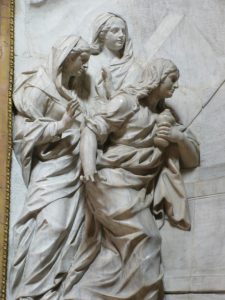 As expressly wished by the Holy Father, the Congregation for Divine Worship and the Discipline of the Sacraments has published a new decree, dated 3 June 2016, Solemnity of the Sacred Heart of Jesus, by which the celebration of St. Mary Magdalene, currently obligatory memory, will be elevated in the general calendar to the level of a feast day.
As expressly wished by the Holy Father, the Congregation for Divine Worship and the Discipline of the Sacraments has published a new decree, dated 3 June 2016, Solemnity of the Sacred Heart of Jesus, by which the celebration of St. Mary Magdalene, currently obligatory memory, will be elevated in the general calendar to the level of a feast day.
We Camillians have the privilege of conserving the memory of our founder, St. Camillus, in the church dedicated to St. Mary Magdalene, the first person to see the empty tomb, the first person to hear the truth of his resurrection, and the woman upon whom, like beneficial balsam, the mercy of the Lord was placed.
In our Order there is only one Camillian community which bears the name of this saint: the ‘St. Mary Magdalene’ community of Fortalesa (Brasile), in the favela of Pirambu, where Fr. Adolfo Seripierro, Fr. Camillo Munaro and Br. Vincente help young women – often only girls – who are pregnant, offering them, as Christ did with St. Mary Magdalene, esteem and the dignity of life.
MARY MAGDALENE: ‘APOSTOLORUM APOSTOLA’
A WOMAN OF MERCY AND WITNESS
‘The decision is situated in the current ecclesial context, which calls upon us to reflect more deeply on the dignity of women, the new evangelisation and the greatness of the mystery of divine mercy. It was St. John Paul II who dedicated great attention not only to the importance of women in the very mission of Christ and the Church, but also, and with special emphasis, to the peculiar function of St. Mary Magdalene as the first witness of the Risen Christ and the first messenger who announced to the apostles the resurrection of the Lord (cf. Mulieris dignitatem, n. 16). This importance remains in today’s Church – as shown by the current commitment to a new evangelisation – which seeks to welcome, without distinction, men and women of any race, people, language and nation, to proclaim to them the good news of the Gospel of Jesus Christ, to accompany them on their earthly pilgrimage and to offer them the wonders of God’s salvation. St. Mary Magdalene is an example of true and authentic evangelisation, that is, an evangeliser who proclaims the joyful central message of Easter’.
‘The Holy Father Francis has taken this decision precisely in the context of the Jubilee of Mercy to stress the importance of this women, who shows great love for Christ and was very dear to Christ, as confirmed by Rabano Mauro (“dilectrix Christi et Christo plurimum dilecta”: De vita beate Mariae magdalenae, Prologus) and St. Anselm of Canterbury (“electa dilectrix et dilecta Electrix Dei”, Oratio a LXXIII Sanctam Mariam Magdalenam). It is certain that the Christian tradition in the West, especially after St. Gregory the Great, identifies as the same person who poured perfume in the house of Simon the Pharisee, and the sister of Lazarus and Martha. This interpretation continued to influence the western ecclesiastical writers, Christian art and liturgical texts relating to the Saint. The Bollandists widely discussed the problem of the identification of the three women and prepared the way for the liturgical reform of the Roman Calendar. With the implementation of the reform, the tests of the Roman Missal, the Liturgy of the Hours and the Martyrologium Romanum, reference is made to Mary of Magdala. It is certain that Mary Magdalene formed part of the group of Jesus’ disciples, that she followed Him to the foot of the cross and in the garden in which she found the tomb, she was the first ‘testis divinae misericordiae’, as St. Gregory the Great affirmed. The Gospel of John says that Mary Magdalene wept, as she had not found the body of the Lord, and Jesus had mercy on her, allowing Himself to be recognised as the Master and transforming her tears into Paschal joy’.
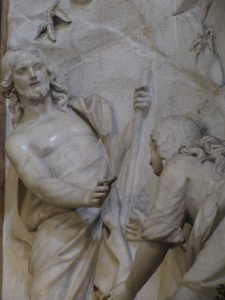 ‘On the one hand, she has the honour of being the ‘prima testis’ to the resurrection of the Lord, the first to see the empty tomb and the first to hear the truth of His resurrection. Christ has a special consideration and mercy for this woman, who shows her love for Him, looking for Him in the garden with anguish and suffering, with ‘lacrimas humilitatis’, as St. Anselm says in the aforementioned prayer. In this sense, I would like to show the difference between the two women present in the garden of Paradise, and in the garden of the Resurrection. The first disseminates death where there was life, and the second proclaims Life from a tomb, the place of death. … Likewise, it is in the garden of resurrection that the Lord says to Mary Magdalene, ‘Noli me tangere’. It is an invitation not only to Mary, but also to all the Church, to enter into an experience of faith that overcomes any materialistic appropriation or human understanding of the divine mystery. It has ecclesial importance! It is a good lesson for every disciple of Jesus: do not seek human securities and worldly honours, but faith in the Living and Risen Christ’.
‘On the one hand, she has the honour of being the ‘prima testis’ to the resurrection of the Lord, the first to see the empty tomb and the first to hear the truth of His resurrection. Christ has a special consideration and mercy for this woman, who shows her love for Him, looking for Him in the garden with anguish and suffering, with ‘lacrimas humilitatis’, as St. Anselm says in the aforementioned prayer. In this sense, I would like to show the difference between the two women present in the garden of Paradise, and in the garden of the Resurrection. The first disseminates death where there was life, and the second proclaims Life from a tomb, the place of death. … Likewise, it is in the garden of resurrection that the Lord says to Mary Magdalene, ‘Noli me tangere’. It is an invitation not only to Mary, but also to all the Church, to enter into an experience of faith that overcomes any materialistic appropriation or human understanding of the divine mystery. It has ecclesial importance! It is a good lesson for every disciple of Jesus: do not seek human securities and worldly honours, but faith in the Living and Risen Christ’.
‘Precisely since she was an eyewitness to the Risen Christ, she was also the first to testify before the apostles. She fulfils the mandate the Risen Christ gives her: ‘go to my brothers and say to them … Mary Magdalene went and announced to the disciples, “I have seen the Lord”—and that he had said these things to her’. In this way she becomes, as is already known, an evangelist, or rather a messenger who announces the good news of the resurrection of the Lord; or, as Rabano Mauro and St. Thomas Aquinas said, ‘apostolorum apostola’, as she announces to the apostles what they in turn will announce to all the world. The Angelic Doctor is right to apply this term to Mary Magdalene: she is the witness to the Risen Christ and announces the message of the resurrection of the Lord, like the other apostles. Therefore it is right that the liturgical celebration of this woman should have the same level of festivity given to the apostles in the General Roman Calendar, and that the special mission of this woman be highlighted, as an example and model to every woman in the Church’.
From the article by H.E. Msgr. Arthur Roche, Secretary of the Congregation for Divine Worship and the Discipline of the Sacraments
Download here the Decree of the Congregation for Divine worship and the Discipline of the Sacraments
THE DELEGATION IN ARGENTINA
Download here the final programme of the twentieth pan-American meeting of people who provide formation and the animators of vocations. This meeting will take place in Buenos Aires on 1-5 September 2016. The general theme is: ‘Vocational Accompanying. Coaching to Humanise Relationships’.
THE PROVINCE OF THAILAND
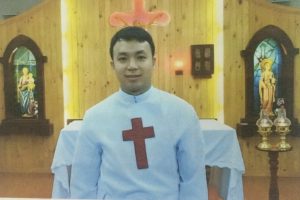 The Superior General, with the agreement of the members of the General Consulta, has admitted to the solemn profession of religious vows seven young religious brothers of ours, temporary professed of the Province of Thailand, of the Delegation of Vietnam: Joseph Hoang Quoc Huy; Joseph Nguyen Quoc Hung; John Baptist Le Van Thoung; Peter Pham Ba Thang; Anthony Vu Phi Song; Joseph Luu Ngoc Khanh (resident in the Camillian community of Taiwan); and Joseph Pham Van Dong (resident in the Camillian community of Taiwan).
The Superior General, with the agreement of the members of the General Consulta, has admitted to the solemn profession of religious vows seven young religious brothers of ours, temporary professed of the Province of Thailand, of the Delegation of Vietnam: Joseph Hoang Quoc Huy; Joseph Nguyen Quoc Hung; John Baptist Le Van Thoung; Peter Pham Ba Thang; Anthony Vu Phi Song; Joseph Luu Ngoc Khanh (resident in the Camillian community of Taiwan); and Joseph Pham Van Dong (resident in the Camillian community of Taiwan).
To them go our very best wishes, with the words of Pope Francis spoken on the day of the recent jubilee for consecrated life (2 February 2016): ‘Our founders were moved by the Spirit and were not afraid to soil their hands with everyday life, with the problems of the people, courageously moving along the geographical and existential peripheries. They did not halt in the face of obstacles and the misunderstandings of others, because they kept in their heart the astonishment over the encounter with Christ. They did not tame the grace of the Gospel; they always had in their heart a healthy apprehension for the Lord, a heartrending desire to bring him to others, as Mary and Joseph did in the temple. We too are called today to make prophetic and courageous choices’.
THE PROVINCE OF ROME
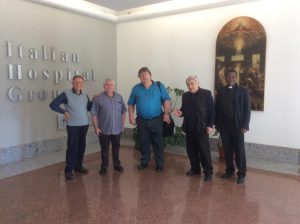 A few days ago the pastoral visit of the Superior General to the communities of the Province of Rome, together with Fr. Laurent Zoungrana, the Vicar General of the Order, came to an end.
A few days ago the pastoral visit of the Superior General to the communities of the Province of Rome, together with Fr. Laurent Zoungrana, the Vicar General of the Order, came to an end.
Here are the principal stages of this visit:
5-6 June: Villa Sacra Famiglia.
7 June: St. John’s Hospital of Rome.
8 June: St. Camillus Hospital of Rome.
9 June: the ‘St. Camillus’ Sanctuary and the ‘Nicola D’Onofrio’ Centre for Spirituality (Bucchianico).
10 June: Viterbo – Villa Immacolata.
11 June: the Camillian Studentate of Rome.
12 June: the St. Camillus de Lellis Parish of Rome. In the afternoon Fr. Leocir and Fr. Laurent visited the ‘Eugenio Litta’ Village of Grottaferrata.
13 June: Villa Sacra Famiglia (final meeting with the general assembly of the Province of Rome).
On Sunday 12 June 2016, the ‘St. Camillus’ Parish of Rome – Via Sallustiana (near toVia Veneto) – celebrated the hundred and tenth anniversary of its foundation: 1926-2016. Fr. Pessini presided over the celebration of the Eucharist as an act of thanksgiving.
MESSAGGIO DEL SUPERIORE GENERALE E DEL VICARIO GENERALE ALLA PROVINCIA ROMANA ITALIANO/INGLESE
ROME – JUBILEE OF THE SICK (12 June 2016)
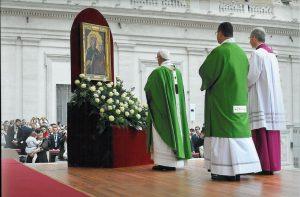 The sacred value of the life of a patient never disappears and never grows dim, rather it shines with more strength specifically in its suffering and its vulnerability. How well one understands the recommendation of St. Camillus as regards caring for the sick. He said: ‘put more heart in those hands’….I like to bless the hands of medical doctors as a sign of gratitude for this compassion’.
The sacred value of the life of a patient never disappears and never grows dim, rather it shines with more strength specifically in its suffering and its vulnerability. How well one understands the recommendation of St. Camillus as regards caring for the sick. He said: ‘put more heart in those hands’….I like to bless the hands of medical doctors as a sign of gratitude for this compassion’.
These were the words of Pope Francis addressed to the directors of the orders of medical doctors of Spain and Latin America whom he received in audience in the morning of Thursday 9 June.
On Sunday 12 June, the picture of Our Lady Salus Infirmorum, which has been kept for centuries in our Church of St. Mary Magdalene in Rome, was on display in St. Peter’s Square during the celebration of the Eucharist presided over by Pope Francis on the occasion of the jubilee of the sick, of people with disabilities, and of health-care workers. Young Camillians receiving formation at the studentate of Monte Mario offered the liturgical service during the Holy Mass.
THE DAUGHTERS OF ST. CAMILLUS
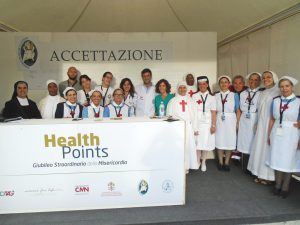 The Daughters of St. Camillus of the ‘Madre Giuseppina Vannini’ Hospital of Rome took part in an active way in the Jubilee of the Sick through an initiative for health sponsored by the Med Tag Foundation. From 10 June until the end of the jubilee, in the neighbourhoods of the four papal basilicas of Rome, ‘health points’ were stationed which offered at no cost – especially to the numerous homeless people in the city – specialised health care. Various specialist medical doctors and health-care personnel were available for consultations in general medicine, dermatology, breast cancer, paediatrics and gynaecology.
The Daughters of St. Camillus of the ‘Madre Giuseppina Vannini’ Hospital of Rome took part in an active way in the Jubilee of the Sick through an initiative for health sponsored by the Med Tag Foundation. From 10 June until the end of the jubilee, in the neighbourhoods of the four papal basilicas of Rome, ‘health points’ were stationed which offered at no cost – especially to the numerous homeless people in the city – specialised health care. Various specialist medical doctors and health-care personnel were available for consultations in general medicine, dermatology, breast cancer, paediatrics and gynaecology.
THE DELEGATION IN ARMENIA
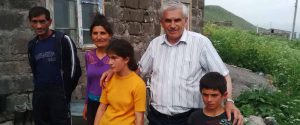 We here share with you an interview with Cardinal Leonardo Sandri, the Prefect of the Congregation for Eastern Churches, who will accompany Pope Francis during his by now imminent voyage to Armenia (24-26 June of this year). The Camillians are also mentioned, above all because of their involvement, which has been going on now for a number of years after the last devastating earthquake, in the management and organisation of health care in the Redemptoris Mater Hospital.
We here share with you an interview with Cardinal Leonardo Sandri, the Prefect of the Congregation for Eastern Churches, who will accompany Pope Francis during his by now imminent voyage to Armenia (24-26 June of this year). The Camillians are also mentioned, above all because of their involvement, which has been going on now for a number of years after the last devastating earthquake, in the management and organisation of health care in the Redemptoris Mater Hospital.
The Redemptoris Mater Hospital is on the plain of Ashotsk, 2,000 metres above sea level. It was built by Italian Caritas in 1991 and then given by Pope John Paul II to the people of Armenia. The management of the hospital has been entrusted since its beginnings to the Camillians. With a hundred beds, it is the centre of a health-care system that covers twenty-two villages with clinics connected to the hospital. The population of the local health-care district is about 15,000 people. Patients come to the hospital from neighbouring Georgia and from every part of Armenia. It is the only hospital that functions regularly and it offers a qualified and free service. There are four departments in the hospital: medicine, surgery, maternity and paediatrics. A paediatrician is employed to provide a service in the villages. Italian medical doctors go to the Redemptoris Mater Hospital to give refresher courses to the medical doctors and nurses who work in it. The area of action for the project is the one that was most hit by the earthquake of 7 December 1988 which caused over 25,000 victims. The earthquake raised to the ground the town of Spitak (20,000 inhabitants), entirely destroyed the city of Giumry (360,000 inhabitants), as well as other inhabited centres, and devastated 400 villages.
L’Osservatore Romano – Avamposto della misericordia. L’ospedale Redemptoris Mater ad Ashtotsk – 19/06/15
Radio Vaticana – Armenia, l’attesa del Papa nelle parole di un religioso – 19/06/16
THE CAMILLIAN COMMUNITY OF GROTTAFERRATA (Rome)
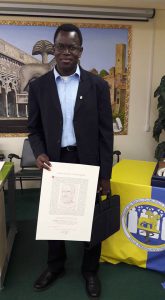 Fr. Modeste Ouedraogo, a Camillian religious from Burkina Faso who in recent years has been a resident of the Camillian community of Grottaferrata, attained the important accomplishment of a degree in medicine and a few days ago took the Hippocratic Oath at the University of Tor Vergata, Rome.
Fr. Modeste Ouedraogo, a Camillian religious from Burkina Faso who in recent years has been a resident of the Camillian community of Grottaferrata, attained the important accomplishment of a degree in medicine and a few days ago took the Hippocratic Oath at the University of Tor Vergata, Rome.
THE VICE-PROVINCE OF BURKINA FASO
 On 23 June last, three of our religious brothers were ordained as deacons.
On 23 June last, three of our religious brothers were ordained as deacons.
The Secretary General of the United Nations (UN), Ban Ki-moon, last March, during his voyage to Burkina Faso, also visited the unit for newly born babies and paediatrics for the admission and treatment of neonates and children with HIV/AIDS of the Hôpital Saint Camille, in Ouagadougou, a hospital managed by our religious brothers of Burkina Faso.
Fr. Paul Ouedraogo, the Vice-Provincial Superior and the director of the hospital, has wanted to share with us the letter that Ban Ki-moon sent him to thank him for his warm hospitality and to congratulate him on the notable work of help and support that the Hôpital Saint Camille offers to people affected by HIV, and not only that! Read the article here
THE PROVINCE OF NORTH ITALY
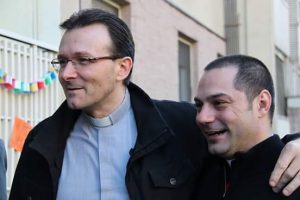 The Superior General, with the agreement of the members of the General Consulta, has admitted to the solemn profession of religious vows Nicola Docimo, a young temporary professed of the Province of North Italy.
The Superior General, with the agreement of the members of the General Consulta, has admitted to the solemn profession of religious vows Nicola Docimo, a young temporary professed of the Province of North Italy.
To him go our best wishes, with the words of Pope Benedict XVI, on the feast day of the Presentation of the Lord, on the occasion of the seventeenth World Day of Consecrated Life (2 February 2013):
‘In this spirit of gratitude and communion I would like to address three invitations to you, so that you may fully enter through that “door of faith” which is always open to us.
- I invite you in the first place to nourish a faith that can illuminate your vocation. For this I urge you to treasure, as on an inner pilgrimage, the memory of the “first love” with which the Lord Jesus Christ warmed your hearts, not out of nostalgia but in order to feed that flame. And for this it is necessary to be with him, in the silence of adoration; and thereby reawaken the wish to share — and the joy of sharing — in his life, his decisions, the obedience of faith, the blessedness of the poor and the radical nature of love. Starting ever anew from this encounter of love, you leave everything to be with him and like him, to put yourselves at the service of God and your brothers and sisters (cf. Apostolic Exhortation Vita Consecrata, 1).
- In the second place I invite you to have a faith that can recognize the wisdom of weakness. In the joys and afflictions of the present time, when the harshness and weight of the cross make themselves felt, do not doubt that the kenosis of Christ is already a paschal victory. Precisely in our limitations and weaknesses as human beings we are called to live conformation with Christ in an all-encompassing commitment which anticipates the eschatological perfection, to the extent that this is possible in time (ibid., n. 16). In a society of efficiency and success, your life, marked by the “humility” and frailty of the lowly, of empathy with those who have no voice, becomes an evangelical sign of contradiction.
- Lastly, I invite you to renew the faith that makes you pilgrims bound for the future. By its nature the consecrated life is a pilgrimage of the spirit in quest of a Face that is sometimes revealed and sometimes veiled: “Faciem tuam, Domine, requiram” (Ps 27[26]:8). May this be the constant yearning of your heart, the fundamental criterion that guides you on your journey, both in small daily steps and in the most important decisions. Do not join the ranks of the prophets of doom who proclaim the end or meaninglessness of the consecrated life in the Church in our day; rather, clothe yourselves in Jesus Christ and put on the armour of light — as St Paul urged (cf. Rom 13:11-14) — keeping awake and watchful.
THE DELEGATION IN KENYA
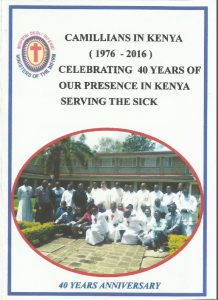 On 16 July 2017, the Camillian Delegation of Kenya will celebrate the fortieth anniversary of the presence of the Camillians in that nation. On behalf of the General Consulta Fr. Aris Miranda will take part in the event which will be held at the hospital of the mission in Tabaka. The Holy Mass will be presided over by the bishop of the diocese of Kissi, Msgr. Joseph Mairura Okemwa.
On 16 July 2017, the Camillian Delegation of Kenya will celebrate the fortieth anniversary of the presence of the Camillians in that nation. On behalf of the General Consulta Fr. Aris Miranda will take part in the event which will be held at the hospital of the mission in Tabaka. The Holy Mass will be presided over by the bishop of the diocese of Kissi, Msgr. Joseph Mairura Okemwa.
THE DELEGATION OF TAIWAN
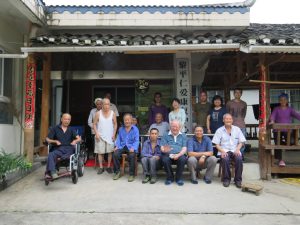 On 28 May the National Eucharistic Congress was held. Three coaches of pilgrims left from our ‘Camillian’ Christian communities of Lotung.
On 28 May the National Eucharistic Congress was held. Three coaches of pilgrims left from our ‘Camillian’ Christian communities of Lotung.
On 3-10 June, Fr. Giuseppe Didonè and Fr. Jojio, together with a group of women nurses, went to China to provide a service of health care to lepers in Yunnan.
On 13 June the Camillian community of Taiwan celebrated the sixty years of priesthood of Fr. Antonio Didoné, who for many years has been gravely ill and living a stationary life. Many people took part, above all the former medical staff of the hospital who knew Fr. Antonio very well. The new chargé d’affaires of the Apostolic Nunciature presided over the ceremony.
Questo video è un commosso omaggio a p. Antonio Didonè religioso, camilliano, sacerdote, medico, innamorato di Taiwan, di quel popolo e dei suoi poveri.
THE PROVINCE OF SPAIN
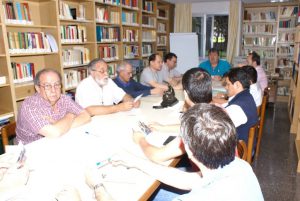 On 24 June to 3 July, the Superior General, Fr. Leocir Pessini, and the member of the General Consulta and general financial administrator Br. Ignacio Santaolalla, will visit the Camillian communities of Spain. This pastoral visit will be an opportunity to learn about the work that is done in each of the various Camillian institutions in Spain. During the visit the superior General will meet co-workers, volunteers, members of the Lay Camillian Family and religious and lay people who every day experience the gift and the charism of St. Camillus.
On 24 June to 3 July, the Superior General, Fr. Leocir Pessini, and the member of the General Consulta and general financial administrator Br. Ignacio Santaolalla, will visit the Camillian communities of Spain. This pastoral visit will be an opportunity to learn about the work that is done in each of the various Camillian institutions in Spain. During the visit the superior General will meet co-workers, volunteers, members of the Lay Camillian Family and religious and lay people who every day experience the gift and the charism of St. Camillus.
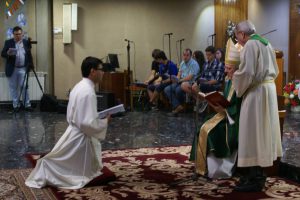 On Sunday 12 June, Msgr. Carlos Osorio ordained our religious brother Franklin Fuentes Huatangari a dean in the church dedicated to St. Camillus, in our Camillian centre of Tres Cantos, Madrid. The new deacon, although he belongs to the Camillian Vice-Province of Peru, is engaging in pastoral care accompanied by his religious brothers of the Province of Spain.
On Sunday 12 June, Msgr. Carlos Osorio ordained our religious brother Franklin Fuentes Huatangari a dean in the church dedicated to St. Camillus, in our Camillian centre of Tres Cantos, Madrid. The new deacon, although he belongs to the Camillian Vice-Province of Peru, is engaging in pastoral care accompanied by his religious brothers of the Province of Spain.
The Camillian Centre organised a work camp to give young people an opportunity to live a week of service for elderly people who are not self-sufficient.
On 10-17 July young people between the ages of 18 and 25 will be offered the possibility of an experience of service and pastoral formation, silence, prayer and encounter that will enable them to explore frailty, care, the meaning of life and the commitment to following Jesus.
THE LITURGICAL FEAST DAY OF ST CAMILLUS DE LELLIS– 14 July 2016
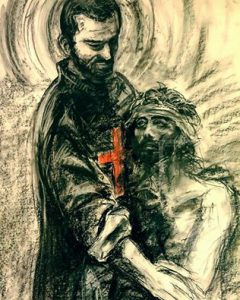 Send us the programmes of your communities for 14 July, the liturgical feast day of St. Camillus de Lellis, and in the days after this feast day we invite you to share with us the photographs and news about this day which is so important for the Camillian world!
Send us the programmes of your communities for 14 July, the liturgical feast day of St. Camillus de Lellis, and in the days after this feast day we invite you to share with us the photographs and news about this day which is so important for the Camillian world!
READING OF THE TRANSIT OF ST CAMILLUS– INGLESE, SPAGNOLO e PORTOGHESE FRANCESE
LITURGY AND PRAYERS FOR THE LITURGICAL CELEBRATION OF 14 JULY
ROME – SAINT MARY MAGDALENE
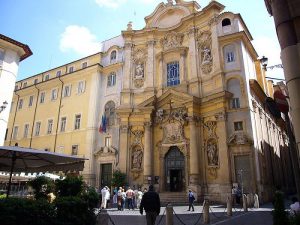 At our community of ‘St. Mary Magdalene’, Rome, the feast day of St. Camillus will be preceded by a triduum of prayer (11-12-13 July) and our church will be open in the evening and during the night (21.00): adoration of the Eucharist; the reading of some writings by and biographical passages on St. Camillus; the possibility of the sacrament of reconciliation; and a visit to the ‘Cubiculum’ and the Camillian Museum.
At our community of ‘St. Mary Magdalene’, Rome, the feast day of St. Camillus will be preceded by a triduum of prayer (11-12-13 July) and our church will be open in the evening and during the night (21.00): adoration of the Eucharist; the reading of some writings by and biographical passages on St. Camillus; the possibility of the sacrament of reconciliation; and a visit to the ‘Cubiculum’ and the Camillian Museum.
On 14 July at 19.00 there will be a solemn celebration of the Eucharist presided over by His Eminence Edoardo Card. Menichelli, the Archbishop of Ancona-Osimo, who was aggregated to the Order of Camillians when he was Archbishop of Chieti-Vasto.
THE PROVINCE OF THE PHILIPPINES
On 12 June 2016 our Camillian religious brothers, the temporary professed of the Philippines, renewed their  vows during the Holy Mass presided over by the Provincial Superior which took place in the new chapel of the school dedicated to St. Camillus.
vows during the Holy Mass presided over by the Provincial Superior which took place in the new chapel of the school dedicated to St. Camillus.
Fr. Seo Jung Ju – Fr. Juya to his friends! – has been consecrated a priest, the first Camillian priest from Korea (he was born in Busan, South Korea). The celebration took place in our Church of St. Camillus and St. Lorenzo Ruiz in Quezon City (Manila).
Fr. Henry Bosoen Angupa II was consecrated a priest in his native parish of the Mountain Province, Holy Family Catholic Mission (the Philippines). At the present time, Fr. Henry is engaging in pastoral service in Taiwan, animating the Christian communities of the indigenous peoples.
To them go our fraternal best wishes, with the words of Pope Francis to priests during the Chrism Mass of Easter Thursday, 2 April 2015:
“My hand shall ever abide with him, my arms also shall strengthen him” (Ps 89:21). This is what the Lord means when he says: “I have found David, my servant; with my holy oil I have anointed him” (v. 20). It is also what our Father thinks whenever he “encounters” a priest. And he goes on to say: “My faithfulness and my steadfast love shall be with him… He shall cry to me, ‘You are my Father, my God and the rock of my salvation”’ (vv. 24, 26).
It is good to enter with the Psalmist into this monologue of our God. He is talking about us, his priests, his pastors. But it is not really a monologue, since he is not the only one speaking. The Father says to Jesus: “Your friends, those who love you, can say to me in a particular way: ‘You are my Father’” (cf. Jn 14:21). If the Lord is so concerned about helping us, it is because he knows that the task of anointing his faithful people is not easy, it is demanding; it can tire us. We experience this in so many ways: from the ordinary fatigue brought on by our daily apostolate to the weariness of sickness, death and even martyrdom.
The tiredness of priests! Do you know how often I think about this weariness which all of you experience? I think about it and I pray about it, often, especially when I am tired myself. I pray for you as you labour amid the people of God entrusted to your care, many of you in lonely and dangerous places. Our weariness, dear priests, is like incense which silently rises up to heaven (cf. Ps 141:2; Rev 8:3-4). Our weariness goes straight to the heart of the Father…
All these emotions…if we do not have an open heart, can exhaust the heart of a shepherd. For us priests, what happens in the lives of our people is not like a news bulletin: we know our people, we sense what is going on in their hearts. Our own heart, sharing in their suffering, feels “com-passion”, is exhausted, broken into a thousand pieces, moved and even “consumed” by the people. Take this, eat this… These are the words the priest of Jesus whispers repeatedly while caring for his faithful people: Take this, eat this; take this, drink this… In this way our priestly life is given over in service, in closeness to the People of God… and this always leaves us weary.
THE PROVINCE OF INDIA
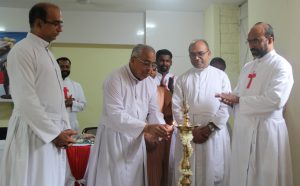 On 2 June the inauguration took place of the diploma in the theology of pastoral care in health at the Camillian centre for pastoral care of Upasana, in collaboration with the pontifical university of DVK. This was a moment of joy and blessing, a grace for the Camillians of India. This new undertaking became a reality at a providential moment, namely the Year of the Jubilee of Mercy, which we are now experiencing with the whole of the Church. We Camillian religious feel proud to be a part of this project given that by our vocations we are called to bear witness prophetically and practically to the merciful love of Jesus, in line with the exemplary model of the Good Samaritan and St. Camillus de Lellis.
On 2 June the inauguration took place of the diploma in the theology of pastoral care in health at the Camillian centre for pastoral care of Upasana, in collaboration with the pontifical university of DVK. This was a moment of joy and blessing, a grace for the Camillians of India. This new undertaking became a reality at a providential moment, namely the Year of the Jubilee of Mercy, which we are now experiencing with the whole of the Church. We Camillian religious feel proud to be a part of this project given that by our vocations we are called to bear witness prophetically and practically to the merciful love of Jesus, in line with the exemplary model of the Good Samaritan and St. Camillus de Lellis.
THE PROVINCE OF SICILY AND NAPLES
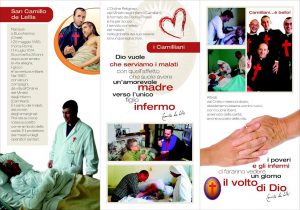 The Provincial committee for formation and the animation of vocations has produced a new vocational pamphlet, conceived for pastoral care for vocations in our communities. This pamphlet has the addresses of the various communities and is enriched by recent photographs of young men who have been involved over recent months in an experience of discernment, according to the gospel style of ‘Come and See’.
The Provincial committee for formation and the animation of vocations has produced a new vocational pamphlet, conceived for pastoral care for vocations in our communities. This pamphlet has the addresses of the various communities and is enriched by recent photographs of young men who have been involved over recent months in an experience of discernment, according to the gospel style of ‘Come and See’.
CADIS
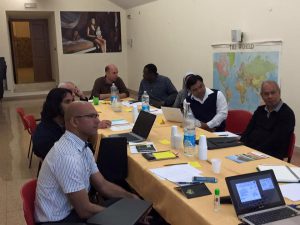 On 30 May to 3 June, at the generalate house in Rome, there took place the first meeting of some of the people who work with CADIS (the Camillian Disaster Service International). Camillian men and women religious from seven different nations and their lay co-workers set to work to explore new strategies for research and the management of funds and resources for the humanitarian activities of our Order.
On 30 May to 3 June, at the generalate house in Rome, there took place the first meeting of some of the people who work with CADIS (the Camillian Disaster Service International). Camillian men and women religious from seven different nations and their lay co-workers set to work to explore new strategies for research and the management of funds and resources for the humanitarian activities of our Order.
One of the first initiatives promoted by the new Foundation, in cooperation with the Province of Austria, has been a programme for women migrants from Syria, Iran, Iraq and Afghanistan. Identified as some of the people most in need, they have been accompanied on a pathway of integration made up of German lessons, cookery courses, painting and music laboratories, but above all else passion and welcome.
THE LAY CAMILLIAN FAMILY
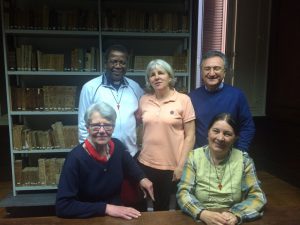 The central committee of the Lay Camillian Family held its annual meeting in Rome at the community of the Church of St. Mary Magdalene on 20-22 May 2016.
The central committee of the Lay Camillian Family held its annual meeting in Rome at the community of the Church of St. Mary Magdalene on 20-22 May 2016.
INTER-CONREGATIONAL LETTER-MESSAGE TO CAMILLIAN MEN AND WOMEN RELIGIOUS
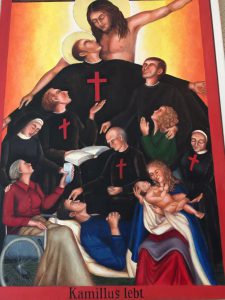 This year as well, continuing the good and by now consolidated tradition of engaging in some moments of prayer and thought together, the general councils, respectively of the Camillians, the Daughters of St. Camillus and the women Ministers of the Sick, after the fraternal meeting of 11 February of this year – the liturgical memorial of Our Lady of Lourdes – finalised a Message on the experience of mercy in St. Camillus and our great heritage of ‘Camillian’ holiness .This is a heritage which is specific to our tradition and should be explored, lived and performed in our contemporary lives.
This year as well, continuing the good and by now consolidated tradition of engaging in some moments of prayer and thought together, the general councils, respectively of the Camillians, the Daughters of St. Camillus and the women Ministers of the Sick, after the fraternal meeting of 11 February of this year – the liturgical memorial of Our Lady of Lourdes – finalised a Message on the experience of mercy in St. Camillus and our great heritage of ‘Camillian’ holiness .This is a heritage which is specific to our tradition and should be explored, lived and performed in our contemporary lives.
READ THE TEXT OF THE MESSAGE – PDF ENGLISH SPANISH FRANCESE
DIARY OF THE SUPERIOR GENERAL AND THE GENERAL CONSULTA
On 1-25 May, the Superior General, together with the members of the General Consulta, Fr. Aris Miranda, Br. José Ignacio Santaolalla and Fr. Gianfranco Lunardon, visited the communities and met our Camillian religious brothers of the Province of Brazil.
MESSAGES OF THE SUPERIOR GENERAL AND THE MEMBERS OF THE GENERAL CONSULTA TO THE COMMUNITIES OF THE PROVINCE OF BRAZIL ITALIANO / INGLESE / PORTOGHESE
On 4-12 June 2016, the Superior General and Fr. Laurent Zoungrana, the Vicar General, met the religious of the Camillian communities of the Province of Rome.
On 4- 11 June, the members of the General Consulta Fr. Aris Miranda and Fr. Gianfranco Lunardon, met individually all the religious of the Camillian communities of Burkina Faso, looking forward to the meeting of the major Superiors which will be celebrated in Ouagadougou next October. On 15 June, at the religious house of the Church of St. Mary Magdalene, Rome, they engaged in dialogue with the Camillian religious of Burkina Faso who live and work in Rome and Viterbo. On Thursday 16 June they went to the Camillian community of Burkina Faso in Florence, prior to their imminent meetings with the religious who live in Pescara and Chieti. Messages ITALIANO/FRANCESE /INGLESE
On 10-25 July of this year, Fr. Leocir Pessini, together with Br. Ignacio Santaolalla, will be in Brazil to visit our religious brothers of the Camillian communities of the North, North-East and East of the country.
On 19- 21 June 2016, together with Fr. Gianfranco Lunardon, the Superior General met the Polish religious of the Camillian community of Berlin.
The Superior General, together with Br. José Ignacio Santaolalla, the general financial administrator, on 22 June to 3 July 2016 will be in Spain to meet the Camillian religious of that country.
 Fr. Aris Miranda from 25 June next will spend a few days in Ethiopia to assess the possibility of cooperation – within the context of Africa – between the Camillians and the Catholic university of Addis Ababa, in particular as regards the field of health care and health formation. This is the response to a direct request of the Bishops’ Conference of Ethiopia and Eritrea.
Fr. Aris Miranda from 25 June next will spend a few days in Ethiopia to assess the possibility of cooperation – within the context of Africa – between the Camillians and the Catholic university of Addis Ababa, in particular as regards the field of health care and health formation. This is the response to a direct request of the Bishops’ Conference of Ethiopia and Eritrea.
DECEASED RELIGIOUS
‘See, now they vanish, the faces and places, with the self which, as it could, loved them. To become renewed, transfigured, in another pattern’ (T.S. Eliot)
 Sister Filippina di Lanzo, a woman Minister of the Sick of St. Camillus, passed away on 31 May at the Casa Betania of Lucca. She was 96 and 77 years of her life had been spent in religious life dedicated with love to service to the sick.
Sister Filippina di Lanzo, a woman Minister of the Sick of St. Camillus, passed away on 31 May at the Casa Betania of Lucca. She was 96 and 77 years of her life had been spent in religious life dedicated with love to service to the sick.
‘Now they live in Christ whom they met in the Church, followed in our vocation, and served in the sick and the suffering. Trusting that the Lord, the Holy Virgin our Queen, St. Camillus, the Blessed Luigi Tezza the Blessed Giuseppina Vannini, and our deceased religious brothers and sisters, will welcome them in their midst, we commend them in our prayers, remembering them with affection, esteem and gratitude’.
THE HOLY YEAR OF MERCY
PRAYER OF THE JUBILEE IN DIFFERENT LANGUAGES
SPEECH OF POPE FRANCIS TO THE DIRECTORS OF THE ORDERS OF PHYSICIANS OF SPAIN AND LATIN AMERICA
Thursday, 9 June 2016
 This year the Church is celebrating the Jubilee of Mercy; this is a good opportunity to express thanks and gratitude to all health-care professionals who, through their dedication, nearness and professionalism towards people affected by illness, can become a true personification of mercy. The identity and the role of a medical doctor is not only based on his learning and his technical competence, it is also, and above all else, based on his attitude of compassion – suffering-with – and mercy towards those who suffer in body and spirit. Compassion is in a certain sense the soul itself of medicine. Compassion is not pity, it is suffering-with.
This year the Church is celebrating the Jubilee of Mercy; this is a good opportunity to express thanks and gratitude to all health-care professionals who, through their dedication, nearness and professionalism towards people affected by illness, can become a true personification of mercy. The identity and the role of a medical doctor is not only based on his learning and his technical competence, it is also, and above all else, based on his attitude of compassion – suffering-with – and mercy towards those who suffer in body and spirit. Compassion is in a certain sense the soul itself of medicine. Compassion is not pity, it is suffering-with.
In our technological and individualistic culture, compassion is not always well regarded; at times it is even despised because it means subjecting the person who receives it to a humiliation. And there is even no lack of people who hide behind a supposed compassion to justify and approve the death of a sick person. But such is not the case. True compassion does not marginalise anyone, it does humiliate a person, it does not exclude him, and even less does it see his death as something that is good. True compassion takes responsibility for a person. You well know that this would mean the triumph of selfishness, of that ‘throwaway culture’ that rejects and despises people that do not come up to certain canons of health, of beauty and of utility. I like to bless the hands of medical doctors as a sign of gratitude for this compassion which becomes a caress of health.
Health is for all people one of the most valuable and wished-for gifts. In the tradition of the Bible the nearness of salvation to health, and their reciprocal and numerous implications, is always highlighted. I like to remember the title with which the fathers of the Church used to call Christ and his work of salvation: Christus medicus, Christ the physician. He is the Good Shepherd who takes care of his wounded sheep and comforts the one that is sick (cf. Ez 34:16); he is the Good Shepherd who does not hold back in front of the wounded person on the side of the road but, moved by compassion, cares for him and helps him (cf. Lk 10:33-34). The tradition of Christian medicine has always drawn inspiration from the parable of the Good Samaritan. This is to identify with the love of the Son of God, who ‘passed by doing good and healing all the oppressed’ (Acts 10:38). How much good is done to the practice of medicine by thinking and feeling that a sick person is our neighbour, that he is of our flesh and our blood, and that in his lacerated body is reflected the mystery of the flesh of Christ himself! ‘Whenever you did one of these things to one of these smallest brothers of mine, you did it to me’ Mt 25:40).
Murals – Chapel of the Camillian community of Macapà – Brazil
Compassion, this suffering-with, is the suitable response to the immense value of the sick person, a response made up of respect, comprehension and tenderness, because the sacred value of the life of a patient never disappears and never grows dim, rather it shines with more strength specifically in his suffering and his vulnerability. How well does one understand the recommendation of St. Camillus de Lellis as regards caring for the sick. He said: “put more heart in those hands”. Frailty, pain and illness are a severe trial for everyone, even for medical staff; they are an appeal to patience, to suffer-with; thus one cannot give way to the functionalist temptation to apply rapid and drastic solutions, moved by false compassion or mere criteria of efficiency and economic savings. The dignity of human life is at stake; the dignity of the medical vocation is at stake. I will go back to what I said about blessing the hands of medical doctors. And although in the practice of medicine, technically speaking, asepsis is necessary, in the marrow of the medical vocation asepsis goes against compassion; asepsis is as necessary as technical help in the practice of medicine but it must never condition the essence of this compassionate heart. It must never condition “put more heart in those hands”.



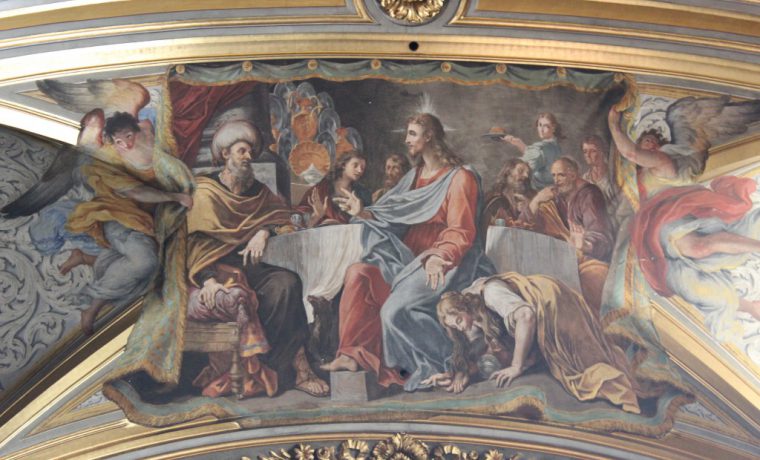






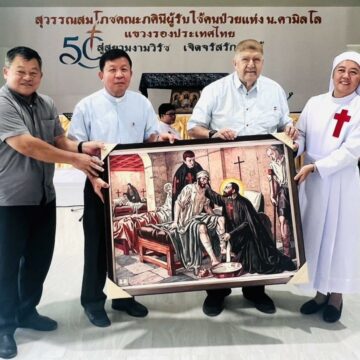
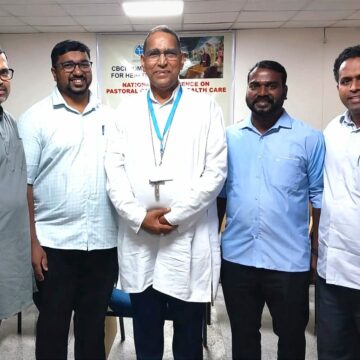


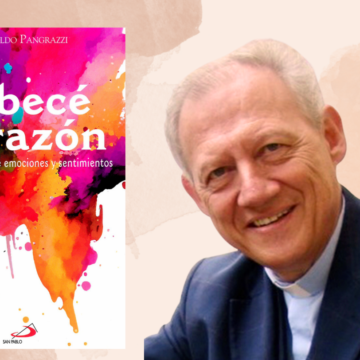
Camillians on Facebook
Camillians on Twitter
Camillians on Instagram